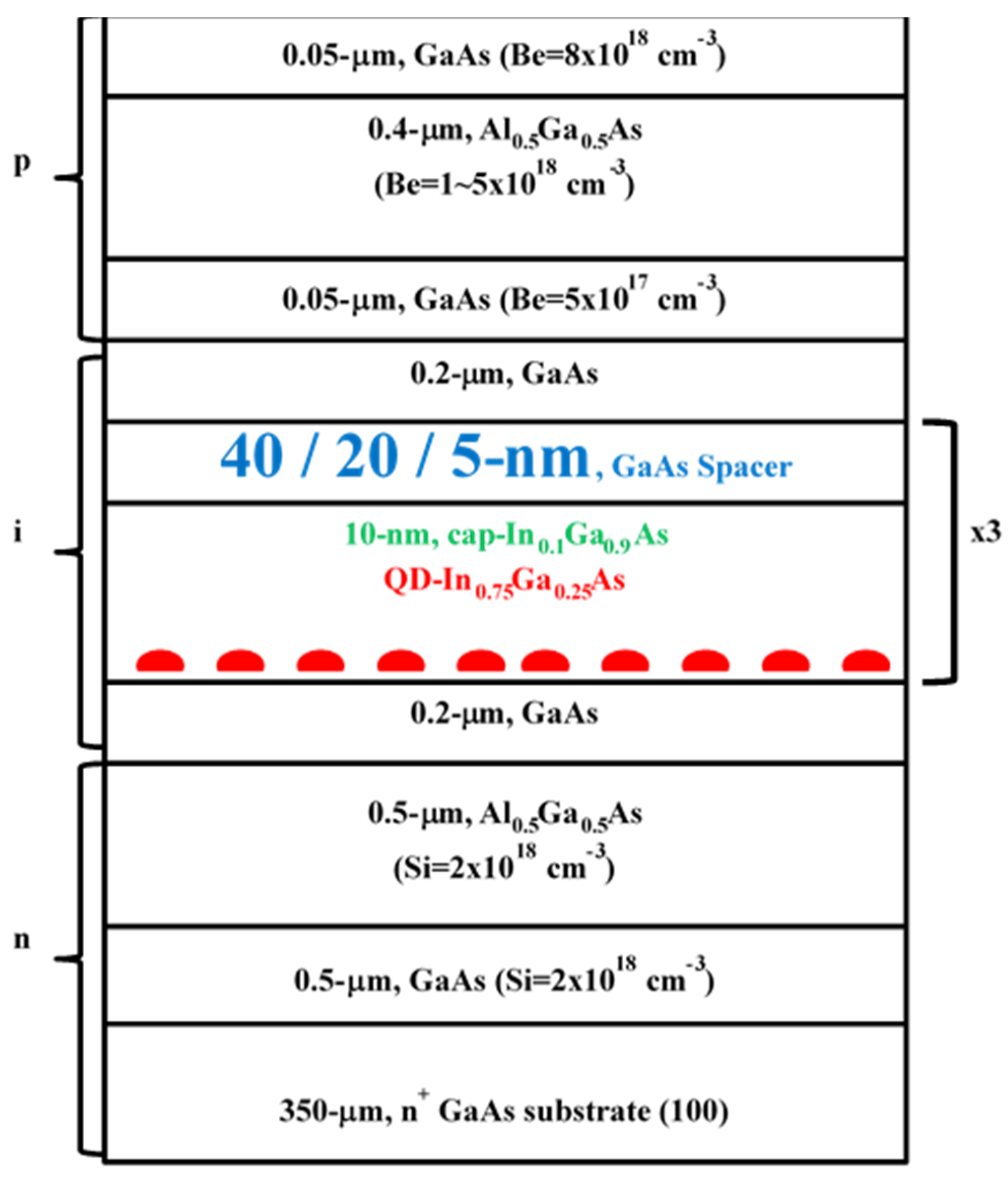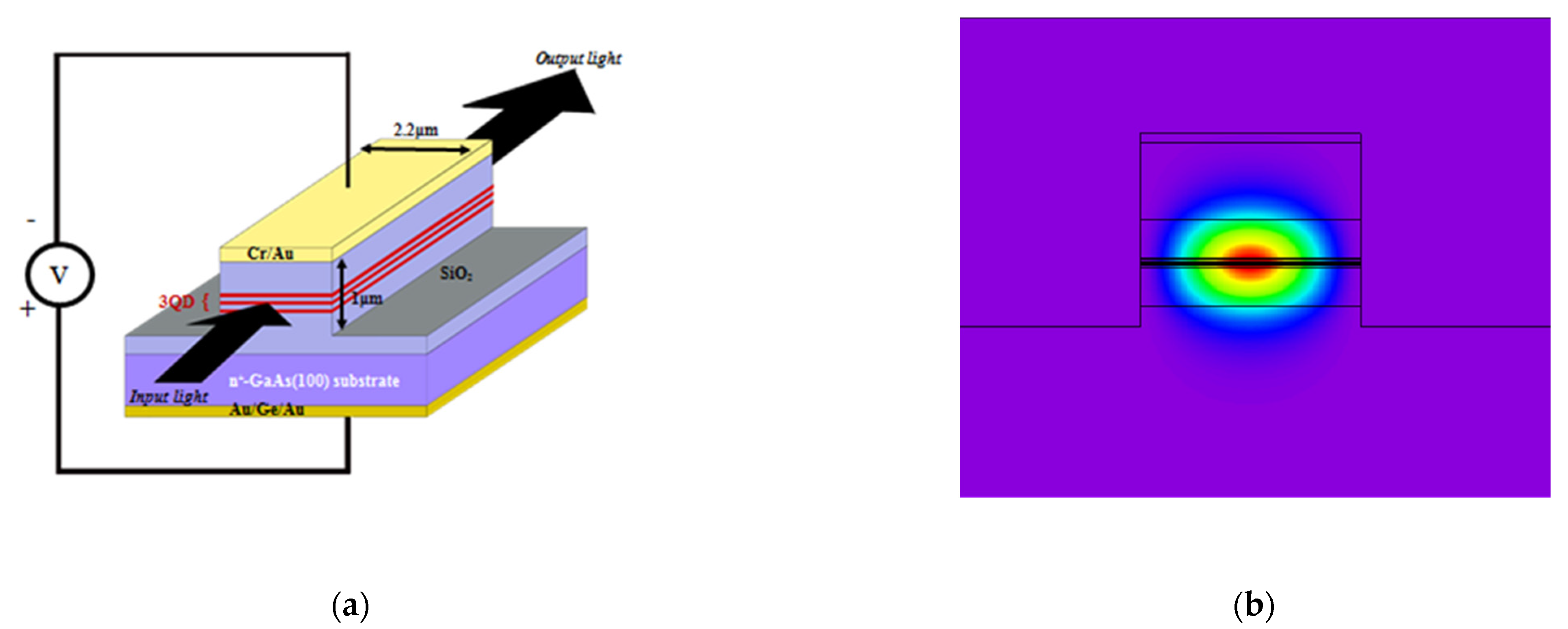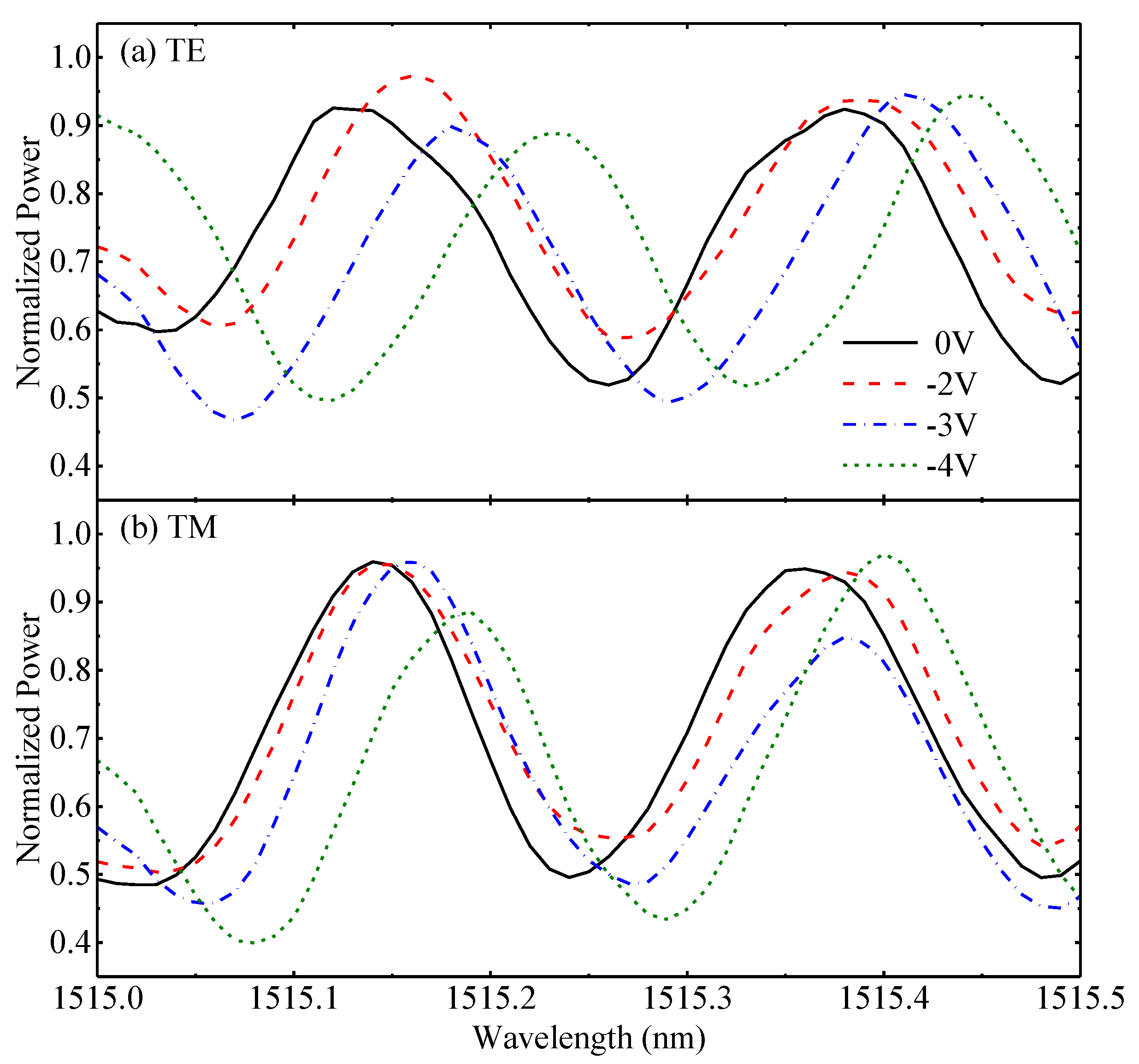Coupled InGaAs Quantum Dots for Electro-Optic Modulation
Abstract
1. Introduction
2. Epitaxial Growth
3. Electroluminescence Spectroscopy
4. Electro-Optic Modulation
5. Conclusions
Author Contributions
Funding
Data Availability Statement
Conflicts of Interest
References
- Schafer, F.; Reithmaier, J.P.; Forchel, A. High-performance GaInAs/GaAs quantum-dot lasers based on a single active layer. Appl. Phys. Lett. 1999, 74, 2915–2917. [Google Scholar] [CrossRef]
- Liu, G.T.; Stintz, A.; Li, H.; Malloy, K.J.; Lester, L.F. Extremely low room-temperature threshold current density diode lasers using InAs dots in In0.15Ga0.85 As quantum well. Electron. Lett. 1999, 35, 1163–1164. [Google Scholar] [CrossRef]
- Novikov, I.I.; Gordeev, N.Y.; Karachinski, L.Y.; Maksimov, M.V.; Shernyakov, Y.M.; Kovsh, A.R.; Krestnikov, I.L.; Kozhukhov, A.V.; Mikhrin, S.S.; Ledentsov, N.N. Effect of p-doping of the active region on the temperature stability of InAs/GaAs QD lasers. Semiconductors 2005, 39, 477–480. [Google Scholar] [CrossRef]
- Martinez, A.; Lemaitre, A.; Merghem, K.; Ferlazzo, L.; Dupuis, C.; Ramdane, A.; Provost, J.G.; Dagens, B.; Le Gouezigou, O.; Gauthier-Lafaye, O. Static and dynamic measurements of the α-factor of five-quantum-dot-layer single-mode lasers emitting at 1.3 µm on GaAs. Appl. Phys. Lett. 2005, 86, 211115. [Google Scholar] [CrossRef]
- Nielsen, D.; Chuang, S.L.; Lee, D.; Kim, N.J.; Pyun, S.H.; Jeong, W.G.; Chen, C.Y.; Lay, T.S. High-speed wavelength conversion in quantum dot and quantum well semiconductor optical amplifiers. Appl. Phys. Lett. 2008, 92, 211101. [Google Scholar] [CrossRef]
- Kim, S.M.; Harris, J.S. Multicolor InGaAs quantum-dot infrared photodetectors. IEEE Photon. Technol. Lett. 2004, 16, 2538–2540. [Google Scholar] [CrossRef]
- Ridha, P.; Li, L.; Fiore, A.; Patriarche, G.; Mexis, M.; Smowton, P.M. Polarization dependence study of electroluminescence and absorption from InAs/GaAs columnar quantum dots. Appl. Phys. Lett. 2007, 91, 191123. [Google Scholar] [CrossRef]
- He, J.; Krenner, H.J.; Pryor, C.; Zhang, J.P.; Wu, Y.; Allen, D.G.; Morris, C.M.; Sherwin, M.S.; Petroff, P.M. Growth, structural, and optical properties of self-assembled (In,Ga) As quantum posts on GaAs. Nano Lett. 2007, 7, 802–806. [Google Scholar] [CrossRef]
- Bayer, M.; Hawrylak, P.; Hinzer, K.; Fafard, S.; Korkusinski, M.; Wasilewski, Z.R.; Stern, O.; Forchel, A. Coupling and entangling of quantum states in quantum dot molecules. Science 2001, 291, 451–453. [Google Scholar] [CrossRef]
- Krenner, H.J.; Sabathil, M.; Clark, E.C.; Kress, A.; Schuh, D.; Bichler, M.; Abstreiter, G.; Finley, J.J. Direct observation of controlled coupling in an individual quantum dot molecule. Phys. Rev. Lett. 2005, 94, 057402. [Google Scholar] [CrossRef]
- Stinaff, E.A.; Scheibner, M.; Bracker, A.S.; Ponomarev, I.V.; Korenev, V.L.; Ware, M.E.; Doty, M.F.; Reinecke, T.L.; Gammon, D. Optical signatures of coupled quantum dots. Science 2007, 317, 929–932. [Google Scholar] [CrossRef] [PubMed]
- Xu, X.; Sun, B.; Berman, P.R.; Steel, D.G.; Bracker, A.S.; Gammon, D.; Sham, L.J. Coherent optical spectroscopy of a strongly driven quantum dot. Science 2006, 311, 636–639. [Google Scholar] [CrossRef] [PubMed]
- Hirao, K.; Asahi, S.; Kaizu, T.; Kita, T. Two-step photocurrent generation enhanced by the fundamental-state miniband formation in intermediate-band solar cells using highly homogeneous InAs/GaAs quantum-dot superlattice. Appl. Phys. Rev. 2017, 11, 012301. [Google Scholar] [CrossRef]
- Okada, Y.; Ekins-Daukes, N.J.; Kita, T.; Tamaki, R.; Yoshida, M.; Pusch, A.; Hess, O.; Phillips, C.C.; Farrell, D.J.; Yoshida, K.; et al. Intermediate band solar cells: Recent progress and future directions. Appl. Phys. Rev. 2015, 2, 021302. [Google Scholar] [CrossRef]
- Tasco, V.; Arianna, C.; Taurino, A.; Cola, A.; Catalano, M.; Salhi, A.; Che, Z.; Kim, M.J.; Lomascolo, M.; Passaseo, A. Inter-level carrier dynamics and photocurrent generation in large band gap quantum dot solar cell by multistep growth. Sol. Energy Mater. Sol. Cells 2017, 171, 142–147. [Google Scholar] [CrossRef]
- Lay, T.S.; Lin, Z.H.; Chuang, K.Y.; Tzeng, T.E. InGaAs quantum dots-in-a-well solar cells with anti-reflection coating. J. Cryst. Growth 2019, 513, 6–9. [Google Scholar] [CrossRef]
- Miller, D.A.B.; Chemla, D.S.; Damen, T.C.; Gossard, A.C.; Wiegmann, W.; Wood, T.H.; Burrus, C.A. Electric field dependence of optical absorption near the band gap of quantum-well structures. Phys. Rev. B. 1985, 32, 1043–1060. [Google Scholar] [CrossRef]
- Amin, R.; Khurgin, J.B.; Sorger, V.J. Waveguide-based electro-absorption modulator performance: Comparative analysis. Opt. Express 2018, 26, 15445–15470. [Google Scholar] [CrossRef]
- Qasaimeh, O.; Kamath, K.; Bhattacharya, P.; Phillips, J. Linear and quadratic electro-optic coefficients of self-organized In0.4Ga0.6As/GaAs quantum dots. Appl. Phys. Lett. 1998, 72, 1275–1277. [Google Scholar] [CrossRef]
- Gosh, S.; Lenihan, A.S.; Dutt, M.V.G.; Qasaimeh, O.; Steel, D.G.; Bhattacharya, P. Nonlinear optical and electro-optic properties of InAs/GaAs self-organized quantum dots. J. Vac. Sci. Technol. B 2001, 19, 1455–1458. [Google Scholar] [CrossRef]
- Moreau, G.; Martinez, A.; Cong, D.Y.; Merghem, K.; Miard, A.; Lemaitre, A.; Voisin, P.; Ramdane, A.; Krestnikov, I.; Kovsh, A.R.; et al. Enhanced In(Ga)As/GaAs quantum dot based electro-optic modulation at 1.55 μm. Appl. Phys. Lett. 2007, 91, 091118. [Google Scholar] [CrossRef]
- Shin, J.; Kim, H.; Petroff, P.M.; Dagli, N. Enhanced electro-optic phase modulation in InGaAs quantum posts at 1500nm. IEEE J. Quantum Electron. 2010, 46, 1127–1131. [Google Scholar] [CrossRef]
- Akca, I.B.; Dana, A.; Aydinli, A.; Rossetti, M.; Li, L.; Fiore, A.; Dagli, N. Electro-optic and electro-absorption characterization of InAs quantum dot waveguides. Opt. Express 2008, 16, 3439–3444. [Google Scholar] [CrossRef]
- Taurino, A.; Catalano, M.; De Giorgi, M.; Passaseo, A.; Cingolani, R. Effects of coupling on the structural properties of InxGa1-xAs/GaAs 1-D and 0-D self-organized quantum structures. Mater. Sci. Eng. 2001, B87, 256–261. [Google Scholar] [CrossRef]
- Moison, J.M.; Guille, C.; Houzay, F.; Barthe, F.; Van Rompay, M. Surface segregation of third-column atoms in group III-V arsenide compounds: Ternary alloys and heterostructures. Phys. Rev. B 1989, 40, 6149–6162. [Google Scholar] [CrossRef]
- Howe, P.; Le Ru, E.C.; Clarke, E.; Murray, R.; Jones, T.S. Quantification of segregation and strain effects in InAs/GaAs quantum dot growth. J. Appl. Phys. 2005, 98, 113511. [Google Scholar] [CrossRef]
- Krost, A.; Heinrichsdorff, F.; Bimberg, D. High-resolution x-ray diffraction of self-organized InGaAs/GaAs quantum dot structures. Appl. Phys. Lett. 1996, 68, 785–787. [Google Scholar] [CrossRef][Green Version]
- Nuntawong, N.; Birudavolu, S.; Hains, C.P.; Huang, S.; Xu, H.; Huffaker, D.L. Effect of strain-compensation in stacked 1.3 μm InAs/GaAs quantum dot active regions grown by metalorganic chemical vapor deposition. Appl. Phys. Lett. 2004, 85, 3050–3052. [Google Scholar] [CrossRef]
- Gerardot, B.D.; Subramanian, G.; Minvielle, S.; Lee, H.; Johnson, J.A.; Schoenfeld, W.V.; Pine, D.; Speck, J.S.; Petroff, P.M. Self-assembling quantum dot lattices through nucleation site engineering. J. Cryst. Growth 2002, 236, 647–654. [Google Scholar] [CrossRef]
- Lay, T.S.; Ying, X.; Shayegan, M. Layer-depopulation- and magnetic-field-induced resistance oscillations in a triple-layer electron system. Phys. Rev. B 1995, 52, R5511–R5514. [Google Scholar] [CrossRef]
- Huang, Y.H.; Pan, Z.; Wu, R.H. Analysis of the optical confinement factor in semiconductor lasers. J. Appl. Phys. 1996, 79, 3827–3830. [Google Scholar] [CrossRef]
- Berseth, C.A.; Wuethrich, C.; Reinhart, F.K. The electro-optic coefficients of GaAs: Measurements at 1.32 and 1.52 μm and study of their dispersion between 0.9 and 10 μm. J. Appl. Phys. 1992, 71, 2821–2825. [Google Scholar] [CrossRef]
- Nishimura, S.; Inoue, H.; Sano, H.; Ishida, K. Electrooptic effects in an InGaAs/InAlAs multiquantum well structure. IEEE Photon. Technol. Lett. 1992, 4, 1123–1126. [Google Scholar] [CrossRef]







| d = 40 nm | d = 20 nm | d = 5 nm | |
|---|---|---|---|
| FWHM (arcs) | 170 | 240 | 400 |
| Δθ (arcs) | –940 | –1600 | –1730 |
| <ε⊥> | 0.0070 | 0.0121 | 0.0131 |
Publisher’s Note: MDPI stays neutral with regard to jurisdictional claims in published maps and institutional affiliations. |
© 2021 by the authors. Licensee MDPI, Basel, Switzerland. This article is an open access article distributed under the terms and conditions of the Creative Commons Attribution (CC BY) license (https://creativecommons.org/licenses/by/4.0/).
Share and Cite
Chuang, K.-Y.; Tzeng, T.-E.; Lay, T.-S. Coupled InGaAs Quantum Dots for Electro-Optic Modulation. Crystals 2021, 11, 1159. https://doi.org/10.3390/cryst11101159
Chuang K-Y, Tzeng T-E, Lay T-S. Coupled InGaAs Quantum Dots for Electro-Optic Modulation. Crystals. 2021; 11(10):1159. https://doi.org/10.3390/cryst11101159
Chicago/Turabian StyleChuang, Kuei-Ya, Te-En Tzeng, and Tsong-Sheng Lay. 2021. "Coupled InGaAs Quantum Dots for Electro-Optic Modulation" Crystals 11, no. 10: 1159. https://doi.org/10.3390/cryst11101159
APA StyleChuang, K.-Y., Tzeng, T.-E., & Lay, T.-S. (2021). Coupled InGaAs Quantum Dots for Electro-Optic Modulation. Crystals, 11(10), 1159. https://doi.org/10.3390/cryst11101159





